|

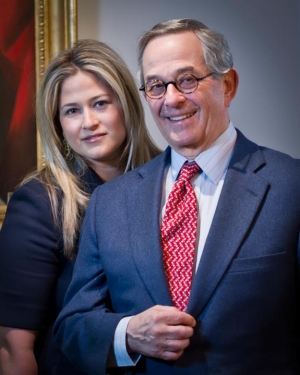
NEW YORK, N.Y. – New York switches into high gear on Sunday, January 15, the official start of Americana Week. Before things get too hectic, make a point of visiting “The World of Duncan Phyfe: The Arts of New York, 1800-1847,”at Hirschl & Adler Galleries through February 17. Gallery president Stuart P. Feld, a longtime enthusiast of American neoclassical design, and his daughter, Elizabeth, managing director of the firm’s decorative arts department, organized this selling exhibition of more than one hundred pieces of furniture, silver, lighting, timepieces, porcelain, painting, prints and sculpture made or used in fashionable New York residences in the first decades of the nineteenth century. Twenty more pieces once sold by Hirschl & Adler have been loaned to the display. Accompanied by a 150-page illustrated catalogue, the exhibition contrasts furniture made by Duncan Phyfe (1770–1854), New York’s best known cabinetmaker, with examples by or attributed to his contemporaries, notably Charles-Honoré Lannuier, Michael Allison, Thomas Seymour, Joseph Brauwers, Thomas Constantine, J. & J.W. Meeks, Alexander Roux and Charles A. Baudoine. Hirschl & Adler’s presentation serves as a pendant to “Duncan Phyfe: Master Cabinetmaker in New York,” the landmark exhibition jointly organized by Peter Kenny of the Metropolitan Museum of Art and Michael Brown of the Museum of Fine Arts, Houston, on view in New York through May 6. Both shows illuminate Phyfe’s underappreciated middle and late periods as never before. This is the fourth collaboration for Feld and Feld, who are celebrating Hirschl & Adler Galleries’ 60th anniversary. Filling five galleries and two hallways, “The World of Duncan Phyfe” is also the first comprehensive display of decorative arts in Hirschl & Adler’s newly renovated, 13,000 square foot quarters in midtown Manhattan, on the fourth floor of the Crown Building. For that reason and many others, a visit is well worthwhile. For more, visit www.hirschlandadler.com. Write to Laura Beach at This email address is being protected from spambots. You need JavaScript enabled to view it.
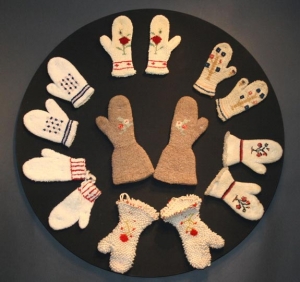
NORWALK, CT. – The scene was gridlock at Beverly Weir’s display of antique Christmas ornaments in Norwalk on December 3, when holiday shoppers came out for the Fairfield County Fine Art & Antiques Show. A new venture organized by Karen DiSaia and Diana Bittel of DiSaia & Bittel Management, the fair assembled 65 of the best known names in the antiques business, from antique jewelry expert Arthur Guy Kaplan of Baltimore to folk art authority Stephen Score of Boston to Arader Galleries, specialists in fine prints. A sparsely attended preview party on Friday, December 2, demonstrated the perils of getting a new show off the ground in a cautious consumer climate and underscored the need for more active involvement by the show’s charity sponsor, Norwalk Hospital. But some exhibitors who came with their holiday best were rewarded with good sales. A line formed at the Christmas display of Weir, a Marlborough, N.H. dealer who spends twelve months a year searching for the delicate glass ornaments and feather trees of holidays past. Her husband, Thomas Longacre, was nearly as successful with painted country furniture and folk art, much of which bore bright, red sold stickers by mid Saturday. Just in time for St. Lucia day on December 13, New York dealer Paul Vandekar added Swedish folk art to his collection of pottery, porcelain and marine-themed art and antiques. From Skane, a colorful wool on linen weft-float embroidered cushion cover dating to the mid 19th century was $15,000. Tom Jewett and Butch Berdan warmed hearts and hands with a collection of Maine-made mittens dating to the 19th century. The Newcastle, Me. dealers’ sales included a painted table, a game board, a hitching post, hooked rugs, a theorem, a folk art carving and a great decorated box. “I sold a superb Prior-Hamblen school portrait of a little boy at the Friday night preview and a grouping of other good pieces on Saturday, including paintings, painted woodenware, and burl,’ said Don Olson of Rochester, N.Y.. “Buyers were very knowledgeable collectors, all of whom I had not met previously. At the end of the show, I still had considerable interest in several significant items, including paintings, a rooster weathervane and an extremely rare inn sign in the form of a hat.” The indicators were positive for Vermont dealers Jeff and Holly Noordsy. “We sold items each day in a broad range of categories. Our greatest success was with early glass,” said Jeff Noordsy. “We saw lots of faces that we typically see in New York City along with some of the suburban families that we previously associated with the Wilton antiques shows.” “People came looking to buy,” said Judy Milne, a Manhattan dealer in folk art and country furniture. Formal furniture and accessories were also moving. Pennsylvania dealer Kelly Kinzle and Connecticut dealer Gary Sergeant each wrote up sideboards Sergeant also sold a pair of Adam torchieres. “Many of my best clients are in Fairfield County. I invited them to the show and brought pieces to show them,” said Sergeant, explaining his success. Organizers made a special effort to stock fine art. One of the most elegant stands belonged to Jeff Cooley of the Cooley Gallery in Old Lyme, Ct. Perfectly suited to the occasion was Leonard Ochtman’s autumnal scene of the Mianus River in nearby Cos Cob, Ct. The oil on canvas painting was $58,000. Savvy veterans of the show circuit, DiSaia and Bittel are already looking at a range of options to strengthen next year’s event. One possibility may be to eliminate the preview party altogether. “We love the venue and think that the show’s a good size. We just need to get some traction,” said DiSaia. “With a little tweaking it will be a big hit,” agreed Tom Jewett. For information, www.fairfieldcountyantiquesandfineart.com. Write to Laura Beach at This email address is being protected from spambots. You need JavaScript enabled to view it..
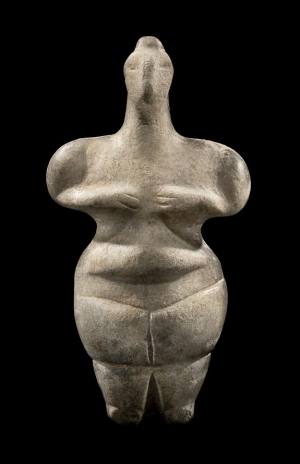
NEW YORK, N.Y. - Anna and Brian Haughton were back at the Park Avenue Armory from October 21 to 27 to stage the International Fine Art & Antique Dealers Show. Seems like yesterday that this London duo took Manhattan by storm, ushering in a new brand of showmanship marked by impeccable presentation, rigorous vetting and a cosmopolitan array of art and antiques offered by some of the world’s leading dealers.
The Haughtons have streamlined their Anglo-American portfolio and now offer two top general-line fairs, the International Show in October and Art Antiques London in June. The latter is planned for June 13-20 at Kensington Gardens .
But do not expect glitz. Haughton fairs are aimed squarely at collectors. Says Anna Haughton, “We are interested in showing the things that real collectors want.”
It may be more old guard than vanguard after 23 years, but the International Fine Art & Antique Dealers Show has not lost its wow factor. Check out our best bets below:
#1 Fertility Goddess
Thin was not in in Thessaly 7,000 years ago. In fact, this voluptuous marble sculpture represented the height of female beauty in the Aegean region of the Neolithic period. Only five inches tall, this tiny totem was a major find at Phoenix Ancient Art of New York.
#2 Chinoiserie Chimneypiece
If there was ever a piece to write home about, it was Ronald Phillips’s George III carved giltwood chimney piece, a monumental ten and a half feet tall and dripping with rococo ornament. The London dealers were asking $1.3 million for the architectural artifact made around 1755, possibly by Matthias Lock, whose original drawing survives at London’s Victoria and Albert Museum.
#3 Bow Owls
Resting on twentieth century ormolu bases, this rare pair of realistically rendered owls was made by the English firm Bow in the 1750s. Brian Haughton Gallery of London offered them for just under $300,000.
#4 Scarlet Secretary
English art and design was anything but boring at Thomas Coulborn & Sons, show newcomers who brought only the highest octane examples. Forget brown furniture, this George II secretary desk was japanned in eye-popping scarlet and gilt. The West Midlands, U.K. dealers wanted $375,000 for the case piece attributed to London cabinetmaker Giles Grendey and dated about 1735.
#5 Mosaic Table Top
Best known for European sculpture from the medieval through Neoclassical periods, Tomasso Brothers dazzled with this micromosaic table top made in Rome in the early nineteenth century with bits of ancient Roman glass. The dealers, whose headquarters is a nineteenth century villa in Leeds, U.K., priced the table top at $140,000.
#6 Regency Commode
This is just a wonderful piece from H. Blairman & Sons, Ltd., the London purveyors of fascinating nineteenth century British furniture and objects. Regency in style, it was designed and manufactured about 1818 by George Bullock, who ornamented the exotic goncalo alves hardwood case with ebony, parcel gilt and brass. The English cabinetmaker topped his creation with marble.
#7 Jade Dagger
Marketplace consolidation eliminated great specialty fairs like the stunningly elegant International Asian Art Fair, which, in retrospect, seems ahead of its time. Fortunately, a few exhibitors from that Haughton enterprise now do the International Show. One is Samina, the London specialist in antique Indian jewelry from the Mughal and Deccan courts. Samina’s star lot, a jade-hilted eighteenth century dagger, sold to a buyer on behalf of a Middle East museum. The price was said to be around $65,000. The timing coincided with the Metropolitan Museum of Art’s grand reopening of its Islamic art galleries.
#8 Royal Dwarf
Born in 1619, Sir Jeffrey Hudson, a dwarf who gained fame as “Lord Minimus,” was given on his seventh birthday to the Duchess of Buckingham, who subsequently presented him to England’s queen. This cast stone and lead sculpture of Minimus was made by Austin & Seeley in 1844 and offered by London dealers Apter-Fredericks at the show. Longleat House in Wiltshire owns a very similar model in lead. Even more extraordinary, a silver “Lord Minimus” turned up at Koopman’s, adjacent to Apter-Fredericks at the International Show.
#9 Wisteria Lamp
Wisteria lamps are the holy grail of Tiffany collectors – one sold for $762,400 at Bonhams in June - even though they are not the rarest thing the Studio produced. This example is one of about 125 originally made, says Arlie Sulka, owner of Lillian Nassau LLC, who offered the trophy dating to around 1906. Lillian Nassau retails American and European decorative arts of the late nineteenth and early twentieth centuries. Marine arts specialists Hyland Granby Antiques are the fair’s only Americanists.
#10 Rockefeller Center Sculpture
Martin du Louvre packed a punch with early modernist sculpture. The centrepiece of the Paris dealer’s display was this eight foot tall atelier plaster, “Elegance,” by Alfred Janniot. The circa 1933 sculpture is a detail for the monumental bronze relief “Friendship between America and France,” made for the La Maison Française at Rockefeller Center in New York. One of Janniot's most important works, it was commissioned by David Rockefeller, at Aristide Maillol's suggestion, and descended in the collection of Rockefeller Center’s architect, Wallace Harrison.
#11 Resin Table
“We reflect the taste of our clients,” says James Harrison of H.M. Luther Antiques. Founded in 1947, the Manhattan-based firm has gradually introduced more twentieth century fare into its grand but richly eclectic offerings. For drama, nothing beat this circa 1970, amber-colored French resin and steel dining table by Marie-Claude de Fouquières, the wife of an industrial plastics producer who created pieces for the Emir of Qatar, David de Rothschild and David Hicks, among others.
#12 Chinese Ink Painting
Flexible datelines have allowed the Haughton shows to change with the times. As Anna Haughton says, “Date is less important than quality. An object needs to stand on its own.” London dealer Michael Goedhuis started as an antiques dealer but is now chiefly interested in contemporary Chinese ink paintings on paper. This 2007 painting, “Scholar’s Rock,” is by Liu Dan, a Nanjing-born artist steeped in Chinese tradition. Goedhuis paired the work, sold for around $250,000, with nineteenth century Japanese bronzes.
#13 Tory Burch’s Kit
Let’s be honest. Half the fun of preview night is people watching. Fashion designer Tory Burch’s kit was definitely one of the most interesting ensembles. Casual with a retro vibe. Definitely not the helmet-haired society matron of past openings at the Park Avenue Armory. And check out those hunky rings.
Write to Laura Beach at This email address is being protected from spambots. You need JavaScript enabled to view it..
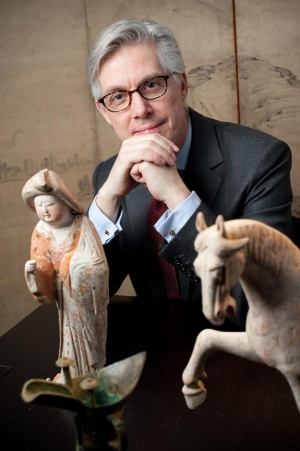
LONDON, ENGLAND – By now it is no secret that newly wealthy Chinese buyers are transforming the global market for art and antiques. Sotheby’s chief executive William Ruprecht recently told the Wall Street Journal that the Chinese are spending $4 billion a year on Chinese paintings alone - more than Sotheby’s and Christie’s combined annual sales of Impressionist, modern and contemporary art. Nearly all of the leading auction houses are seeking Mandarin-fluent staff.
But despite their assertive auction presence, Chinese buyers are scarce at the West’s leading art and antiques shows, a challenge for dealers looking to groom new collectors. That may be about to change. In late September, representatives from the European Fine Art Fair (TEFAF), organized each March in the Dutch city of Maastricht, made their first visit to China.
Led by TEFAF chairman Ben Janssens, the group hosted receptions for collectors in Beijing and Shanghai and were received by officials at the splendid Shanghai Museum. In Beijing, they visited the Palace Museum at the Forbidden City, the new National Museum of China at Tiananmen Square, and the Capital Museum, which showcases the imperial city’s storied past.
The friend-raising tour was part of a global campaign to market TEFAF, regarded by some as the world’s leading venue for traditional art and antiques. TEFAF, which celebrates its 25th anniversary in 2012, is hosting an event in another BRIC country, Brazil, in late October. Between December and February, TEFAF representatives will wine and dine their way through Milan, Munich, Lisbon, Paris, Luxemburg, Amsterdam and Brussels.
AFAnews.com recently spoke to Asian art dealer Ben Janssens from his gallery on London’s Jermyn Street, where his specialties include early Chinese pottery, porcelain, bronze and jade as well as later Ming and Qing dynasty objects.
AFAnews: What prompted TEFAF’s trip to China?
BJ: Over the past three years, TEFAF has welcomed groups of Chinese collectors, albeit in fairly limited numbers. We have been thinking about doing something in China but wanted to wait until the time was right. Until now, Chinese collectors have mainly been interested in Chinese art. That is beginning to shift, so it seemed right that we should go. Interestingly, Chinese museums are also beginning to look much more to the West. The Capital Museum is hosting “Van Gogh and the Amsterdam Impressionists.” An exhibition of Bulgari jewelry and “Art of the Enlightenment” - organized by the Berlin National Museum, the Dresden National Art Collection Museum and the Bavarian State Picture Galleries - are at the National Museum.
AFAnews: Who was in the TEFAF delegation?
BJ: It was really just me and our head of marketing, Titia Vellenga. We were assisted in China by two people, TEFAF representative Xiaoling Xu, and an American, Mike Bruhn. Mike has lived in China for 20 years. He was with Sotheby’s in Hong Kong and now has his own business based in Beijing and Shanghai. He organizes events and launches for Western brands and is quite involved in marketing various museums in China. We were also joined by a TEFAF exhibitor, Mark Schaffer of A La Vieille Russie in New York, who had concurrent business in China.
AFAnews: How many Chinese collectors are visiting TEFAF?
BJ: They mostly come in groups although a few Chinese collectors travel individually. We recently had a collecting circle from Nanjing and another from Shanghai. The visits are well organized. We help with travel planning and translators to make it easier for them. Many Chinese would like to visit the fair but the logistics are difficult. We have offered similar assistance for many years to groups all over the world.
AFAnews: Did TEFAF reach out to institutions or individuals?
BJ: The mission was really to target as many private collectors as possible. In Beijing, we hosted a reception and dinner for about fifty collectors at the residence of the Dutch ambassador. Some institutions were represented, as well. We approached our visit to Shanghai quite differently. We had a presentation at the Chinese Collectors Club, which limits its numbers. We tried to give them an impression of what the fair was like through an audio-visual presentation. Altogether, we met 120 collectors in Beijing and Shanghai. Many expressed their interest in coming to TEFAF Maastricht.
AFAnews: I understand that the group was hungry for facts and figures.
BJ: That’s typical for Chinese audiences. I was prepared for it. Some questions we can answer, such as what percent of our exhibitors are Asian art specialists (about ten percent). There are many things we can’t easily answer, such as what the sales turnover is at TEFAF.
AFAnews: Was the trip a success?
BJ: There is huge interest in the fair. We noticed that TEFAF is very much recognized as a brand and Chinese collectors do see us as such. There was some curiosity about whether we might mount a TEFAF fair in China.
AFAnews: Will you?
BJ: You never know. The idea would require much more exploration to make sure that it was the right step.
AFAnews: Does TEFAF host similar events in other parts of the world?
BJ: We adapt the formula to where we are. In most cases, invitations are extended by participants in our fair. So far we have had only one exhibitor from China, Meg Maggio of Pekin Fine Arts. She was in our Showcase. We have done events in South America and in European countries where there is not widespread awareness of TEFAF. We haven’t yet visited Russia or the Middle East.
AFAnews: Will TEFAF change to reflect the increasingly global nature of the art market?
BJ: I think it already has. Five years ago, when I became chairman, there wasn’t much Asian art at Maastricht. Now we have a comprehensive selection, including three dealers in Japanese art. Three years ago we introduced contemporary design. We try to be as responsive as we can to the general public.
AFAnews: Many dealers have had limited success selling to Chinese collectors. Why is that?
BJ: I think it has to do with what you sell. My focus is on early Chinese art and also Ming and Qing ceramics and for that there is definitely a clientele in China. But it’s not easy. You have to go there and be responsive. The approach is very different than what we are used to in Europe. You have to wait.
AFAnews: Is language the primary obstacle?
BJ: There was a very good reason why TEFAF decided to have a Chinese language site about three years ago. It is completely in Chinese. And for most dealers, the same thing goes. I have just produced a catalog with Chinese captions for my participation in Asia Week in London in November. The auction houses got onto this very early and have had the means to develop it. They definitely got the march on dealers but dealers are catching up. The Chinese market is now one that no one can afford to ignore.
Postscript
The Chinese market is indeed one that no one is ignoring, least not the Chinese.
In a follow-up exchange with AFAnews.com, TEFAF’s marketing chief Titia Vellenga remarked on the speed with which the Chinese art market is developing.
“In 2009, China became the third largest art market globally with a market share of 14%. In 2010, it overtook the second position of the UK that dropped from 27% to 22%, whereas the Chinese art market share in 2010 was 23%,” she said.
Others are also working to facilitate more East-West exchange. The mainland auction house, China Guardian, is opening offices in New York and London this fall. According to The Art Newspaper, it seeks to repatriate consignments of Chinese art but has not ruled out selling Western art, as well. And Hong Kong dealer Andy Hei hosted the seventh edition of Fine Art Asia from October 3-7 at the Hong Kong Convention Center. The fair, whose stated aim is to be “Asia’s Maastricht,” coincides with the Asian capital’s fall auctions. Among its ninety-plus exhibitors are Apter-Fredericks Ltd., a founding partner of London’s Masterpiece fair and his colleagues Berwald Oriental Art, M.D. Flacks, Michael Goedhuis, Geoffrey Diner Gallery, Nicholas Grindley and Carlton Hobbs. Unlike TEFAF, Fine Art Asia is unvetted.
Write to Laura Beach at This email address is being protected from spambots. You need JavaScript enabled to view it.
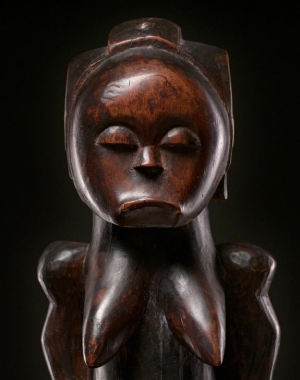
NEW YORK CITY –As opening-night galas collide with triple-digit drops in the Dow, swings in the financial markets are wreaking havoc with art and antiques shows. New and revamped fairs will no doubt invigorate the market in the coming season but older events are declining under the weight of rising costs and disappointing sales.
There are exceptions, of course. Market consolidation is actually benefitting the 58-year-old Winter Antiques Show, which through good management has solidified its traditional standing. Late last week, executive director Catherine Sweeney Singer finalized the short – very short – list of additions to the fair that previews on Thursday, January 19, continuing at New York’s Park Avenue Armory through January 29.
“We have the lowest attrition rate in the world. It’s very unusual that we have more than a couple of replacements a year,” Sweeney-Singer said by phone late Friday.
The Winter Antiques Show is the flagship event for Americana Week in Manhattan even though only a third of its exhibitors specialize in American fare. Its bona fides in the Americana field have just been strengthened with the addition of Kindig Antiques of Lancaster, Pa., and Joan R. Brownstein and Peter H. Eaton of Newbury, Ma.
Jenifer Kindig and her father, Joe Kindig III, carry on the firm founded by Jenifer’s grandfather, Joe Kindig, Jr., a leading advisor to Henry Francis du Pont and other top collectors. The Pennsylvania dealers are equally well known for seventeenth through early nineteenth century American furniture as for early American rifles, art forms in themselves.
The felicitous partnership of Eaton and Brownstein combines Eaton’s long expertise in early, high-country New England furniture in original surfaces with Brownstein’s keen eye for American folk paintings. In recent years, Brownstein has made a minor specialty of Mary and Edwin Scheier’s Modernist pottery, examples of which Brownstein will bring to the fair.
From his Massachusetts showroom, Eaton said that he has half a dozen things under wraps, literally. “None of this furniture came through auction. I am keeping it under blankets until January. I don’t want to be tempted,” said the dealer.
The market for furniture and ceramics of the American craft movement has grown dramatically since Philadelphia dealer Robert Aibel handled his first piece by George Nakashima 27 years ago. Ahead of his time, the founder of Moderne Gallery also pioneered the work of Wharton Esherick, Wendell Castle, Sam Maloof and David Ebner, examples of which Moderne plans to exhibit in New York. Aibel briefly participated in the Philadelphia Antiques Show but resigned when he was not allowed to bring craft-movement furniture, a restriction that now seems quaintly short-sighted.
Peter Fetterman, a Santa Monica, Ca., dealer in vintage photography, is replacing his colleague Han Kraus, who is taking a leave of absence from the Winter Show. Initially a filmmaker and collector, Fetterman has amassed one of the largest inventories of classic twentieth century fine-art photography by Cartier-Bresson, Ansel Adams, Caponigro, Kertesz and others.
A conflict with the Brussels Non European Art Fair’s winter exhibition has caused London dealer Kevin Conru to withdraw from East Side. Pace Primitive of New York is taking Conru’s place. Director Carlo Bella said that his gallery will show eighth to nineteenth century sculpture from Africa to China, pairing it with works on paper by modern masters who were influenced by primitive art.
“We do four catalogued exhibitions a year at our gallery on 57th Street, so the Winter Antiques Show is a departure for us,” said Bella.
The Winter Antiques Show has thus far resisted the influence of Masterpiece, the two-year old London fair that broke the mold by adding new, branded luxury goods to the mix.
“We want people to have confidence that if they come to an antiques show they will see antiques,” says Sweeny-Singer. Three years ago, the Winter Show moved its dateline forward to 1969 for exhibitors dealing in twentieth century material. Dealers in pre-twentieth century works of art are allowed no more than a sprinkling of modern pieces.
Coinciding with “Duncan Phyfe: Master Cabinetmaker in New York,” at the Metropolitan Museum of Art from December 20 to May 6, the 2012 Winter Antiques Show loan display honors the upstate New York institution Historic Hudson Valley. The presentation marking the 60th anniversary of John D. Rockefeller Jr.'s founding of Sleepy Hollow Restorations, now Historic Hudson Valley, showcases fine and decorative art from Phillipsburg Manor, Van Cortlandt Manor, Washington Irving’s Sunnyside, Montgomery Place, and the Union Church of Pocantico Hills.
Complete with Twitter feed and a Facebook link, the Winter Antiques Show’s upgraded website is set to be launched in the coming days.
Write to Laura Beach at This email address is being protected from spambots. You need JavaScript enabled to view it..
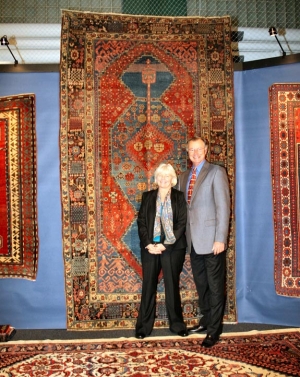
In my last post, I alerted readers to possible changes afoot at Antiques Week in New Hampshire, the annual August gathering of Americana collectors. AFAnews can now confirm that promoter Karen DiSaia is moving ahead with plans for a new event that will precede the August 9-11 New Hampshire Antiques Show in 2012. Arrangements for DiSaia’s as yet unnamed fair are already well along. It is scheduled for Wednesday and Thursday, August 8 and 9, at Manchester’s JFK Memorial Coliseum, a venue that has been tested by several other promoters over the past decade. The facility is air-conditioned and equipped with parking, not insignificant selling points. “A few years ago, a large group of dealers asked me if I could organize such a show but I only recently began looking into it seriously,” said Di Saia, who is finalizing her dealer list. Presenting 35 to 40 exhibitors, the new fair will emphasize Americana but other specialties have not been ruled out. DiSaia organizes such stalwarts as the ADA/Historic Deerfield Show, the Washington Winter Show and the Connecticut Spring Antiques Show. Her past credits include New York’s American Antiques Show, which she produced on behalf of the American Folk Art Museum. DiSaia recently took on the management of USArtists, the fine arts show and sale at the Pennsylvania Academy of the Fine Arts from September 22-25. Karen and her husband, Ralph, the facilities manager for a half dozen high-profile events, are longtime dealers who operate Oriental Rugs, Ltd. in Old Lyme, Ct. www.disaiamanagement.com Fairfield County ShowThe DiSaias are also teaming up with Diana Bittel - the Philadelphia area antiques dealer who manages the Newport, Wayside Inn and Delaware antiques shows - to launch the new Fairfield County Show. The 60-dealer fair benefitting Norwalk Hospital is set to preview at the Sono Field House, a new athletic facility in Norwalk, Ct. on Friday, December 2, continuing through the weekend. The Fairfield County Show fills a void left by the passing of two traditional mainstays, the Greenwich and Southport-Westport antiques shows. As its high-power roster makes clear, the Fairfield County Show will be strong in a full range of American fine and decorative arts but will venture into English, European and Asian categories as well. www.fairfieldcountyantiquesandfineart.com Ellis Boston Antiques ShowBoston-based marketing and p.r. wizards Tony Fusco and Robert Four are relaunching Boston’s oldest and best known fair, renaming it the Ellis Boston Antiques Show. Set to preview Thursday, October 20, at the Cyclorama at Boston Center for the Arts, 539 Tremont Street, the show will continue through October 23. Befitting its big city setting, the elegant presentation will feature 40 recognized specialists in formal English and American decorative arts - Alfred Bullard, Georgian Manor, Roberto Freitas and The Federalist, among them – as well as experts in folk art, Oriental rugs, ceramics, maps and prints, antiquities and jewelry. About a quarter of the exhibitors are veterans of the old Ellis show. Prominent fine arts specialists include Vose Galleries of Boston and William Vareika Fine Art of Newport. “We have no 100-year restriction, which we think is arbitrary for an antiques show today,” said Fusco, who promises twentieth century design in the booth of Andrew Spindler and others. The show benefits Ellis Memorial, Boston’s first settlement house, founded in 1885. Funds are earmarked for the renovation of two historic buildings on Berkeley Street that are key to Ellis’s programming plans. Fusco, a founder of the Art Deco Society of Boston and a member of Ellis Memorial’s Preservation Committee, and Four also manage the fifteen year old Boston International Fine Art Show and the five year old AD20/21, incorporating Art and Design of the 20th and 21st Century and the Boston Print Fair. www.ellisboston.com. Pavilion of Art and Design New YorkProduced by the Société d'Organisation Culturelle and Sanford L. Smith & Associates, the Pavilion of Art and Design New York looks to be one of the most interesting introductions to the fall show calendar. Europeans account for the majority of its 49 high-end specialists in modern art, design, decorative arts, photography, jewelry and tribal art from the 1890s to the present. Big names from the United States include Barry Friedman Ltd, Hammer Galleries, Todd Merrill, Jason Jacques and Paul Kasmin of New York but it is the roster of European specialists – 13 from London and another 10 from Paris, plus dealers from Switzerland, Italy and Sweden – that makes this debut novel. “This is completely new to America. Most of the Continental dealers have never done a show in New York,” says impresario Sandy Smith, whose stable of events includes the Outsider Art Fair, the New York Antiquarian Book Fair and the Art Show, organized by Smith on behalf of the Art Dealers Association of America. Paris antiques dealer Patrick Perrin and the contemporary art specialist Stephane Custot of Galerie Hopkins Custot in London founded the original Pavilion des Arts & du Design in Paris in fifteen years ago and followed with the Pavilion of Art and Design London in 2007. Coinciding with New York’s fall Impressionist, Modern, Contemporary art and design auctions, PAD NY runs from Thursday, November 10, to Monday, November 14, at the Park Avenue Armory. www.padny.net Metro Show NYCHeaded by Mark Lyman and Michael Franks, the Art Fair Company is at work on a new show to replace the American Antiques Show, a pivotal part of Americana Week in New York in January. Called the Metro Show, the updated fair will open at Manhattan’s Metropolitan Pavilion at 125 West 18th Street on Wednesday, January 18, one night before the 58th Winter Antiques Show and will continue through January 22. Veteran director Caroline Kerrigan Lerch is currently working with dealer-advisors Amy Finkel, Carl Hammer, Samuel Herrup, Tim Hill, Allan Katz and Frank Maresca to fill the 45-dealer fair. Expect to see returning favorites such as Galerie St. Etienne along with newcomers like Kevin Morris, a New York dealer in self-taught art and Japanese baskets. “We are striving for an interesting mix and texture,” said Kerrigan Lerch, who is working to add twentieth century photography, design and decorative arts to what was once exclusively Americana. Lyman and Franks produce Spring Show NYC, organized on behalf of the Art and Antique Dealers League of America, plus the Sculpture Objects & Functional Art (SOFA) expos in New York, Chicago and Santa Fe. Do not expect to find contemporary craft at the Metro Show, however. “There’s no overlap. This is not a contemporary show,” says Kerrigan Lerch. www.metroshownyc.com Write to Laura Beach at This email address is being protected from spambots. You need JavaScript enabled to view it..
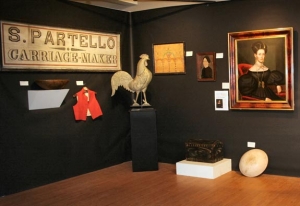
MANCHESTER, N.H. – The two-day Mid Week in Manchester Antiques Show got off to a robust start on Wednesday, August 10.
“Attendance was up slightly from last year, about 8 or 9 percent, but the high quality of the gate is what matters and a number of dealers did very well. The bulk of selling was on Wednesday but there were be-backs on Thursday and business did take place,” said manager Frank Gaglio of Barn Star Productions in Rhinebeck, N.Y.
This was Mid Week’s final appearance at the Furniture World Building, which has been sold. The 18-year-old fair spent its first fifteen years at the Wayfarer Inn in nearby Bedford, N.H.
Gaglio, who also manages the 23rd Street Armory Antiques Show in Philadelphia, the Autumn Hartford Antiques Show and several other popular events, is now on the hunt for a new venue for his two New Hampshire shows, the 93-exhibitor Mid Week, a cornerstone of Antiques Week in New Hampshire, and his August 8 Pickers Market, which has 80 dealers.
With a venue change pending, there is also speculation that one or possibly two new shows may form in the already crowded Antiques Week calendar, siphoning off some disaffected Mid Week exhibitors who dislike following the Pickers Market in the same venue.
“We are very proud of our relationship with our dealers and want to include them in our decision process,” Gaglio told AFAnews.com. In questionnaires circulated after the shows, Gaglio polled exhibitors to see if they want Mid Week and Pickers Market to merge or to remain separate entities.
“We are looking at all of the responses but to some degree facility availability will dictate how we go forward,” said Gaglio, who has not ruled out moving his events out of the area if no suitable venue is found locally. “We want to build a relationship with an institution or facility that will provide a permanent home for our shows.”
Gaglio defended his current line-up, telling AFAnews.com, “The Pickers Market fills the gap between Northeast Auctions, which ends on Sunday, and Nan Gurley’s show on Tuesday. It was originally on Friday but we were losing exhibitors because of the late night set-up. The Pickers Market defrays costs for Mid Week. We sell a two-show ticket at the Pickers Market which also helps ensure a viable audience for Mid Week.”
Mid Week in Manchester boasts some of the nation’s foremost Americana specialists.
American needlework experts Stephen and Carol Huber unveiled an important Salem, Ma., embroidery on black silk by Anstiss Crowninshield, circa 1740. The work, which depicts a shepherd and shepherdess in a pastoral setting with a house and dogs, is the mate to one at Salem’s Peabody Essex Museum. The Hubers, whose new book, With Needle and Brush: Schoolgirl Embroidery from the Connecticut River Valley, 1740-1840, is due off the press any day, reported good attendance at their annual open house in Old Saybrook, Ct., following the close of Antiques Week.
“It’s been very active. I sold several pieces of furniture plus lighting, baskets and accessories,” said Merrimac Port, Ma., dealer Colette Donovan, who paints a pleasing palette with 18th century textiles and early country furniture. A highlight was her red-painted child’s drop-front desk with a shapely bracket base, $9,500.
The desk was recently illustrated in Antiques and Fine Art magazine, as was a striking portrait of a handsome, well-groomed young woman with upswept hair and a penetrating gaze by New England painter John S. Blunt. Don Olson, a dealer from Rochester, N.Y., offered the painting that accompanied Deborah M. Child’s article, “Coming of Age: The Marine Paintings of Samuel Blunt.”
Color was a unifying theme at Samuel Herrup Antiques, where a pair of paint-decorated Regency tables, $11,500, joined W.M. Prior’s winsome portrait of little girl in blue holding a red book, $35,000, and a large hooked rug of a dog, $19,500. A portrait of sea captain, possibly Caleb Cook of Salem, Ma., was $14,000.
“I did well and I always enjoy this show,” said South Salem, N.Y., dealer John Keith Russell, whose display included a Dunlap School armchair, $7,500, from southern New Hampshire. Wrapped in a green tarp, a Shaker table waited for its buyer to claim it. On August 6 at Northeast Auctions, Russell was the winning bidder on another Shaker table, a trestle-base example from the Claire Cook collection, hammered down at $64,900.
Furniture sold well for several Mid Week exhibitors. Shaftsbury, Vt., dealers Norman and Mary Gronning parted with a tiger-maple chest in old surface, an 18th century Massachusetts armchair retaining portions of its original upholstery, a tavern table, a painting and smalls. “We even had a couple of follow ups,” said Mary Gronning.
A 17th century New England six-board blanket chest, $4,950, with gouged decoration was much admired at Gronning Antiques, as was a circa 1710 Connecticut River Valley linen-fold chest with incised heart decoration, $19,500, in the booth of Ohio dealers David Good and Sam Forsythe.
“Business has been excellent,” said Sam Forsythe, reeling off a list of sales that included a ladder-back armchair, fraktur, treen, baskets, redware, folk art, a hat box, an early canteen and a theorem.
Don Heller and Kim Washam‘s sumptuous display combined furniture, accessories and a large, round, late 19th century wooden carving of the Seal of the Commonwealth of Massachusetts, $36,000, embellished with an Indian who may be Massasoit of the Wampanoags. The Maine dealers’ sales included a dwarf tall clock from Massachusett’s South Shore, a Queen Anne chair, a set of Rhode Island brace-back Windsor chairs, a Hudson Valley great chair, a Boston compass seat chair, a Hepplewhite stand and assorted shelves, accessories and doll furniture.
Write to Laura Beach at This email address is being protected from spambots. You need JavaScript enabled to view it..
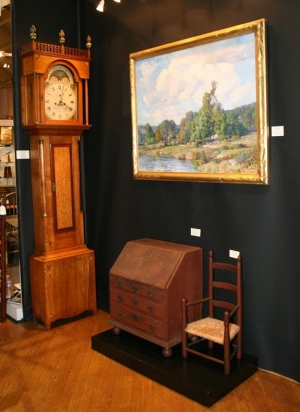
MANCHESTER, N.H. – Shoppers looking for a little retail therapy and a respite from the volatile stock market found it at the New Hampshire Antiques Show. The 54th annual event got underway at the Radisson in Manchester, N.H., on Thursday morning, August 11, when hundreds of buyers stormed the show to get first pick of early New England arts offered by 67 exhibitors.
“It’s like gold,” Bev Longacre, co-manager of the three-day event sponsored by the New Hampshire Antiques Dealers Association, said of the rush to invest in weathervanes and game boards, hooked rugs and paint-decorated accessories.
Now is indeed a good time to buy. As Peter Pap, a dealer in antique Oriental rugs in nearby Dublin, N.H., wrote in his latest newsletter: “So much advice is out there about investing in hard assets, with people fixating on commodities like gold and silver and not thinking seriously about buying fine art…Carefully selected” antiques, while generally not as liquid as silver or gold, “could be a really good move right now” and “have also proven to be stable investments,” noted Pap.
“People are having fun and investing in concrete things,” agreed Bev Longacre.
Her husband, Marlborough, N.H., dealer Thomas R. Longacre, saves colorful folk art and country furniture for a year for the New Hampshire Antiques Show, displaying it to advantage in a light, bright stand that appeals to customers looking to incorporate Americana into contemporary interiors.
“We had the right stuff at the right prices and the right plan to display it,” said Longacre, a 34-year veteran of the fair whose walls were papered with sold tags barely two hours after opening.
Longacre’s neighbors, Russ and Karen Goldberger, also did well, restocking their booth daily to fill in gaps left by their many sales of folk art, painted furniture and decoys. The Rye, N.H., dealers have recently rebalanced their business approach, cutting their schedule back to one antiques show a year while doubling down on e-commerce.
The show’s onsite shipper said that orders for deliveries, often a barometer of furniture sales, declined this year. Business was nevertheless robust for Gail and Don Piatt, who ticketed a settle, a step-back cupboard and a three-drawer blanket chest; for Michael Whittemore, who wrote up a Rhode Island Queen Anne tea table, two weathervanes, eight game boards and hooked rugs; and Jan Whitlock, who, enjoying her best New Hampshire Antiques Show ever, sold a dry sink, a collection of pen wipes, scalloped shelves and a Baltimore baby’s quilt.
Peter Sawyer and Scott Bassett sold two of their best pieces, a New Hampshire bow-front, drop-panel chest of drawers of contrasting woods and an Aaron Willard, Jr., tall clock, priced $85,000, with rocking-ship dial and an engraved paper label by Paul Revere. “The only one with a better case is in the collection of the Museum of Fine Arts, Boston,” said Bassett.
Competitive pricing plus no sales tax makes the New Hampshire Antiques Show a favorite of collectors. Probably from the Duxbury, Ma., area, a circa 1760-85 Queen Anne maple chest-on frame with curvaceous legs and skirt was a highlight at Nathan Liverant & Son of Colchester, Ct., where it was reasonably priced at $19,500.
Another furniture specialist, Newbury, Ma., dealer Peter Eaton, sold a Massachusetts maple and oak gate-leg table acquired from legendary New Hampshire dealer Roger Bacon in the 1960s, plus several other pieces of furniture and a painting.
Eaton’s partner, paintings specialist Joan Brownstein, devoted a separate booth to works on paper, among them an 1837 double portrait by J.H. Davis of the Deerfield, N.H., girls Eunice and Lurana Marden, $39,000, and a collection of illuminated manuscript drawings from the copy book of Dolle Green of Weare, N.H., circa 1794, $34,000.
Two exceptional 19th century watercolor portraits of a mother and a daughter by the Pennsylvania itinerant Henry Young turned up at Newsom & Berdan of Thomasville, Pa. “I just though they were wonderful,” said Betty Berdan, who bought them recently at a country auction where they were consigned by descendants of the sitters.
Marine and China trade specialist Paul de Coste featured two 1830s whaling logs, $22,000, from New Bedford, Ma., for the ships Delight and Hydaspe. Hydaspe was the first whaling ship built on the Mystic River in Stonington, Ct.
Needlework expert Amy Finkel parted with samplers from Washington City; Trenton, N.J.; Montville, Ct.; and Danville, Vt., but sold no furniture, which is unusual for the Philadelphia dealer.
New Hampshire-based Russack & Loto Books had strong interest in ceramics references from the library of a noted conservator. Said Judy Loto, “We are looking to buy any good book collection. People who have been collecting for twenty or thirty years are generally great sources for us.”
This year’s New Hampshire Antiques Show was supported by a newly invigorated marketing campaign that included extensive color advertising in trade publications, e-couponing and a review by an Associated Press reporter that made national news.
“The gate might have been up a hair from last year,” said Pembroke, N.H., dealer Thomas M. Thompson, the show’s co-chair, noting that increased attendance on Thursday and Saturday was offset by a slight decline on Friday.
While many participants believe that the formula for one of the most successful, longest running antiques shows in history should not be tampered with, at least one exhibitor floated the idea of moving the fair up a few days to catch shoppers before fatigue sets in and to dovetail more closely with Northeast’s annual August Americana auction, considered the kick-off to Antiques Week in New Hampshire.
“The New Hampshire Antiques Show is the market leader and should come first,” said the dealer.
Write to Laura Beach at This email address is being protected from spambots. You need JavaScript enabled to view it..
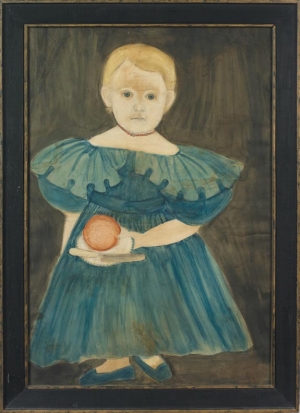
The Dow collapsed this week to lows not seen in many months. But even as investors flee the stock market there are signs, at least for now, of renewed confidence in art and antiques.
I am thinking especially of Northeast Auctions’ August 5-7 sale in Manchester, N.H., featuring nearly 1,700 lots of fine and decorative arts, much of it Americana. To give you a sense of the Americana market’s gyrations, Northeast’s sales at this annual event plummeted from $9.43 million in 2008 to $2.62 million in 2009, rebounding this year to $4.6 million.
Folded into the three-day marathon, the catalogued sale of folk art from the collection of Helen and Steven Kellogg helped make the difference. A month ago in this space, I predicted that this thoughtful assemblage would lift the folk-art market in August.
Was I right? Yes and no. Including premium, the Kellogg collection came in near its global estimate of $1.4 million. In general, the trade bid cautiously, leaving collectors to pick and choose among the best pieces, sometimes paying half of what they had been prepared to bid. As I write, buyers are negotiating privately on some of the passed lots and dealers are getting multiple offers on items they picked up inexpensively.
“This was a very personal and extremely interesting collection. It was put together with a great deal of passion for the material and a personal point of view,” said Patrick Bell, the Pennsylvania dealer who acted as a consultant to the Kelloggs.
Assembled during the height of the country Americana collecting movement of the 1960s through the 1980s, the Kellogg collection documented an era while offering evidence of how taste has changed. Prices for works that hang on a wall or sit on a pedestal or shelf have steadily advanced but the romanticized ideal of the period interior has passed, taking with it the taste for antique furniture that receives daily use. One dramatic example of this trend was a rare set of eight initialed arrow-back chairs in yellow paint with red floral decoration. Purchased from the prominent Connecticut dealer Fred Giampietro, they barely mustered $3,166 with premium.
Another way of looking at how inexpensive country Americana has become is to compare prices from this sale with those achieved at the 1994 sale of the collection of Bertram K. and Nina Fletcher Little. Of five objects owned by both the Littles and the Kelloggs, three brought higher prices in 1994, surely an indication that present values are in many instances depressed.
Early American Rugs
Four rugs from the Kellogg collection brought $16,500 or more each, a very good result. The top price, $73,160 (est. $15/20,000) including premium, was for a late 19th century hooked rug with great graphics and a muted palette. Decorated with two horses flanking a central star, this rug, as well as a shirred chenille example that sold for $25,960 (est. $10/15,000), are “textbook,” says auctioneer Ron Bourgeault. Both are illustrated in Joel and Kate Kopp’s classic reference, American Hooked and Sewn Rugs: Folk Art Underfoot, published in 1985. The highwater mark for rug sales was 2004, when Northeast auctioned a room-sized hooked rug for $79,500 and a runner by Magdalena Briner for $74,000.
Folk Sculpture
Sculpture was not something that the Kelloggs collected in depth. The exception to the rule was the cover lot, a late 19th century carousel figure of a giraffe attributed to Daniel Muller of the Dentzel Company in Philadelphia. It had the great form and untouched paint that collectors want. The fact that several contenders already own similar figures may have dampened the price of the figure, which nevertheless doubled low estimate to bring $101,480 (est. $50/75,000). A large, hollow-cast chalk cat with smoke decoration was competitively bid to $27,140 (est. $6/8,000).
Folk Portraiture
Folk portraiture can be a tough sell and the Kelloggs owned a lot of it. Their sophisticated preference for edgy primitivism put them at odds with a wider public seeking colorful, undemanding pictures of children. Winners in this category included a pair of Micah Williams’ circa 1820 pastels on paper of a New Jersey couple, Mr. and Mrs. Smalley, for $129,800 (est. $15/20,000); an oil on canvas portrait of a woman attributed to the Beardsley Limner, $35,400 (est. $25/35,000); and R.W. and S.A. Shute’s watercolor portrait of child in a blue dress holding an orange, $70,800 (est. $25/35,000). Two John Brewster, Jr., pastels of little girls holding flowers sold for a combined $63,720. Losers? One, inexplicably, was a Shute double portrait of children. Estimated at $20/25,000, it failed to meet its reserve. Another was a pair of oil on canvas portraits of a New Hampshire couple attributed to Erastus Salisbury Field. Formerly the property of the pioneering dealer Edith Gregor Halpert, the pair brought only $11,800 against an estimate of $15/20,000.
Painted Furniture
An early 19th century New England chair table made news in 2000 when it brought $21,850 at Northeast’s sale of the Virginia Cave collection. Bought in this time at est. $20/$25,000, its whimsical, late 19th century painted decoration was clearly not to everyone’s taste. Alternately, a Maine blanket chest of circa 1820 doubled its low estimate to sell for $30,680. It had everything collectors look for: high bracket feet, shaped skirt, architectural details and appealing blue and ochre grained decoration. Ditto a grained red-over-ochre New Hampshire chest of drawers, $25,960, with high bracket feet and the date 1766 inscribed on its back. Massachusetts dealer Sam Herrup acquired it at the Little sale in 1994 for only $6,038. It resold for $25,960.
Write to Laura Beach at This email address is being protected from spambots. You need JavaScript enabled to view it..
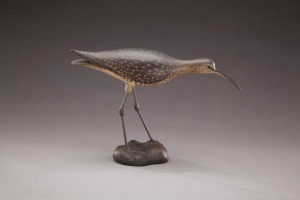
The migratory habits of collectors were on display in late July as buyers of sporting art made their annual swing through coastal New England. Prices for decoys and fine art depicting sportsmen’s pursuits rose dramatically until 2007, cresting that year with Guyette & Schmidt’s auction of a red-breasted merganser hen by Lothrop Holmes (1824-1899) for $856,000 and Stephen O’Brien Jr.’s private sales of two A. E. Crowell (1862-1952) decoys for $1.13 million apiece. Following a steep fall-off, prices have begun to climb back in this clubby, traditionally male-dominated field. As the recent round of auctions demonstrates, Crowell, the best known of the decorative carving movement’s early 20th century pioneers, is still king. COPLEY FINE ART Copley Fine Art Auctions’ July 21-22 Sporting Sale in Plymouth, Ma. was 86 percent sold by lot and fell squarely within its estimated range, garnering roughly $2.5 million on just over 650 lots. Nearly 300 potential buyers from around the country previewed the event. About half of all registered bidders were in the room. The Boston-based firm logged its biggest internet sale to date with N.C. Wyeth’s “One January Afternoon,” an oil on canvas of 1915 that made $86,250, 22 percent less than its price at Skinner just nine years ago. - Copley’s cover lot, a circa 1912 running curlew made by A. Elmer Crowell, set a new auction record for a decorative shorebird by the carver when it brought $247,250 (est. $60/90,000). Copley sold a comparable carving for $189,000 in 2007. “We had four bidders up to $190,000. Two final bidders, one in the room and one on the phone, carried it to $215,000 plus premium,” O’Brien said. [Lot 380]
- A jack curlew by Crowell set a record at auction for a miniature shorebird when it hammered down at $12,650 including premium against an estimate of $4,000 to $5,000. The pigment and pattern on the circa 1910 sculpture are nearly identical to that on the cover lot, the full size running curlew above. [Lot 340]
- Offered at auction for the first time, a circa 1870 canvas-covered swimming old squaw by Lothrop Holmes of Kingston, Ma. achieved $218,500 (est. $150/250,000). It is from a well-known rig found in the Boston area in the 1960s. The buyer also claimed the subsequent lot, a Holmes old squaw drake from the same rig, for $74,750 (est. $60/90,000). [Lot 518]
- “It was in excellent condition and had good provenance, which is key with decoys by Lee Dudley (1860-1942),” O’Brien said of a Knott Island, N.C., canvasback drake that dated to around 1890. It surpassed estimate to bring $69,000. The decoy is thought to have been part of a rig made for a member of the Dudley’s Island Club, owned by Lee’s twin brother, Leonard. Dudley carvings have long been prized by collectors. [Lot 629]
- Though of later date and factory made, Mason decoys enjoy a solid following, especially among Pacific Coast collectors. A circa 1910 Hudsonian curlew by Mason exceeded estimate to bring $37,375. It was also the top-selling Mason decoy in the 1996 auction of the John A. Hillman collection, where it achieved $15,400. [Lot 584]
- “Springers and Pheasants,” an oil on canvas painting of 1948 by Aiden Lassell Ripley (1896-1969), made what O’Brien believes is a record auction price, $97,750 but, contradictorily, failed to meet its $100/200,000 estimate. “We based the estimate on a Ripley watercolor that we sold a few years ago. This is one of three paintings that I believe to be the artist’s best. Perhaps a lower estimate would have generated more bidding activity,” said O’Brien. [Lot 27]
GUYETTE & SCHMIDT Guyette & Schmidt’s July 19-20 sale in Portsmouth, N.H., was its best summer event in four years, grossing roughly $1.5 million on 592 lots. The two-day session called by Fairfield, Me., auctioneer James Julia saw a 43 percent increase in online bidders and a 15 percent increase in bidders in the room from a year ago. The partnership also hosts seasonal events in Maryland, Ohio and Illinois, acknowledging the broadly North American interest in sporting art as well as the regional nature of many individual collections. “Quality sells in a weaker economy. Collectors are seeking the best,” said founding partner Gary Guyette. Material of Pacific Coast, Louisiana, Virginia and North Carolina interest performed especially well. - As elsewhere, the graceful sculptures of East Harwich, Ma. carver A.E. Crowell took top honors. Leading the flock was a circa 1900 willet that boasted fine detail, excellent condition and desirable provenance. It sold at the low end of its range for $57,500, the same price paid for Lot 316, a full size decorative golden plover featured in Brian Cullity’s 1992 loan exhibition and catalogue on Crowell for Heritage Plantation Museum in Sandwich, Ma. [Lot 106]
- An old squaw drake, maker unknown, was found near Rockland, Me., in 1968 by Don Snyder, who sold it to the consigner in the mid 1980s. An appealing form and a finely executed head pushed the price of this bird to $24,725 (est. $12/15,000). A rig mate is displayed at the Maine State Museum. [Lot 90]
- A comprehensive new book, The Stevens Brothers: Their Lives, The Times and Their Decoys by Dr. Peter J. Muller and Peggy Lane Muller, has invigorated the market for works by these New York carvers. Dating from the 1880s, a rare golden-eye drake in eclipse plumage, a special order from maker George Stevens, sold for $18,400 (est. $14/16,000). [Lot 42]
- Rarer than most Crowells, a curlew made by Walter Brady of Oyster, Va. in the last quarter of the 19th century brought $48,875 (est. $40/60,000). [Lot 387]
- A late 19th century running knot from Cobb Island, Va., was purchased at auction a decade ago for around $16,000 and resold for $25,875. [Lot 393]
- Dating to the last quarter of the 19th century, a well sculpted bluebill drake from a member of the Doughty family of Hog Island, a barrier island on Virginia’s eastern shore, fetched $18,975. [Lot 458]
- A rare rig mate pair of green wing teal by Mitchell LaFrance of Saint Sophie, La., more than doubled low estimate to bring $18,975. [Lot 67]
DECOYS UNLIMITED “Even though we did not have a major collection to build around, overall sales were much stronger than a year ago. Some of our market is sportsmen but bird lovers are also a big part, especially for the decorative bird carvings,” Ted Harmon said of the auction that he and his wife, Judy, organized in Hyannis, Ma. The July 24-25 event realized roughly $1.4 million with premium. Of special note were A.E. Crowell miniatures from the collection of Joseph Bard French. - A prized possession of Dr. George Ross Starr, a sicklebill curlew found in Duxbury, Ma. roared past estimate to sell for $111,550. A rare form in near mint condition, it came from the Fox family in Chatham, Ma. “We had two people who wanted it badly,” Harmon explained. [Lot 358a]
- “We got close but it passed,” Harmon said of a red-breasted merganser hen, possibly dating to the late 19th century, by Franklin Pierce Wright of West Barnstable, Ma. It passed at $54,000. “This is the most important merganser I’ve ever seen. I’d like it to stay on the Cape or go to a museum,” says the auctioneer, who is negotiating a private sale. [Lot 533a]
- A circa 1900 hissing Canada goose by George Boyd, New Hampshire’s premier carver, fetched $60,375. “We had one last year. News of its sale bought this one out of the woodwork,” said Harmon. [Lot 79]
- A pair of red-breasted mergansers made by Maine carver Irving Wallace in the early 20th century went for $37,375. “The form, condition and rarity are incredible,” says Harmon. [Lot 81]
- A late 19th century sanderling made by the Chipman family of Sandwich, Ma. fetched $23,000. “We sold one for $90,000 in 2006. This one had a replaced bill,” the auctioneer explained. The Chipman brothers made wooden molds for the Sandwich Glass Factory. The cobalt eyes used for these birds is said to be Sandwich glass. [Lot 142]
- The Harmons deal in other arts of Cape Cod, including pictures by the Cahoon family. “King Neptune,” a painting on board with two mermaids and the god of the sea by Ralph Cahoon of Cotuit, Ma. achieved $24,150. A second Cahoon, depicting a Chinese auctioneer offering two mermaids for sale, made $23,000. [Lot 435]
Write to Laura Beach at This email address is being protected from spambots. You need JavaScript enabled to view it.
|
|
|
|
|